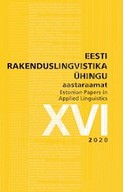MÄNGUSTATUD ÕPPETEGEVUSTE MÕJU ÜHEKSANDA KLASSI ÕPILASTE SUHTUMISELE EESTI KEELE KUI TEISE KEELE TUNDIDESSE
THE EFFECT OF GAMIFIED LEARNING ACTIVITIES ON THE ATTITUDES OF 9TH GRADE PUPILS TOWARDS LESSONS OF ESTONIAN AS A SECOND LANGUAGE
Author(s): Mare Kitsnik, Pirgita-Maarja HallasSubject(s): Foreign languages learning, Finno-Ugrian studies, School education, Educational Psychology
Published by: Eesti Rakenduslingvistika Ühing (ERÜ)
Keywords: learning motivation; learning activities; gamification; second language learning; Estonian language;
Summary/Abstract: Learning motivation and attitudes towards studying are considered to be among the essential factors influencing academic results. Despite this, teachers often underrate the part that learning activities, methods and materials play in forming pupils’ motivations and attitudes (Metslang et al. 2013). Both Gardner (2007) and Dörnyei (1994, 2001) consider the specific learning situation, or events happening in the classroom, as an important factor of learning motivation. This article focuses on teachers’ options to affect pupils’ attitudes towards Estonian lessons via gamified learning activities. The term gamification is generally defined “the use of game design elements in a non-game context” (Deterding et al., 2011). This study involved an experiment with 9th graders in a Russian-language school in Tallinn, Estonia. During the three-month experiment, six learning groups had a weekly Estonian language lesson, where the language was exclusively studied with gamified learning activities. The teacher in their first year at the school prepared and taught these lessons using a variety of materials. The other Estonian lessons were taught by other teachers in a more traditional manner. The pupils were instructed to answer a questionnaire both at the beginning and the end of the experiment. Before the experiment, 67 pupils commented on and evaluated their experiences of Estonian lessons taken during a period of eight years. After the experiment, 77 pupils commented on and evaluated their experiences of gamified Estonian lessons. The pupils evaluated the lessons in a Likert scale (1–7) according to ten factors (usefulness, necessity, interest, activeness, variance, modernity, fun, energy, atmosphere, ease) and commented the learning activities. The pupils evaluated the traditional lessons of Estonian language as the second language rather highly. The usefulness (6 on average) and necessity (5.6) were evaluated the highest. Modernity (4.9.), interest (4.6), atmosphere (4.6), variance (4.4), activity (4.3) were also rated above average. Two factors had ratings beyond the average: energy (3.7) and fun (3.5). In the gamified lessons, compared to the traditional lessons of eight years, the factor of fun increased the most (from 3.5 to 5.5, an increase of two). The ratings of energy and ease (1.3) were also higher. However, the evaluations of usefulness and necessity of gamified lessons were lower. The average ratings of usefulness fell respectively by one (from 5.6 of the traditional lessons to 4.6) and 0.7 (from 6 to 5.3). The average evaluations of other factors did not show notable differences. Notably, evaluations varied both by groups and individually.
Journal: Eesti Rakenduslingvistika Ühingu aastaraamat
- Issue Year: 2020
- Issue No: 16
- Page Range: 77-94
- Page Count: 18
- Language: Estonian

